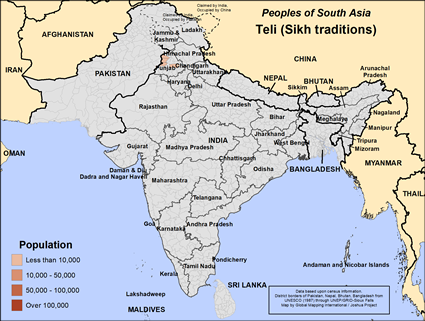Within the caste system of India there are numerous communities which have a given task to benefit others. The Teli community is one of these. "A community which derives its name from the Sanskrit word talika or taila, used for the oil extracted from sesame and mustard, thus alluding to their traditional occupation... Mythological origin of the Teli is traced to Lord Shiva who created them to destroy five demons. However, their legend also says that the first Teli was created by Shiva to rub him with oil." (Singh, K. S., India's Communities, p. 3462)
Telis were traditionally considered one of the Vaisya, or trading communities. That put them as part of the third highest of four caste clusters.
Sikh Telis live mainly in Punjab State, though a few are in Uttar Pradesh.
The Teli community once did the labor-intensive job of pressing and extracting oil, but now that job is done by mechanical means. For this reason, some have mainly resorted to farming or animal husbandry. A good many of these are landless, and some have applied to be considered "Other backward castes" so they can receive special treatment from the Indian government. A smaller number of them are businessmen or hotel managers, metal workers, cart pullers, or common laborers. Many are now in government jobs, and they are active in politics.
The Teli people are endogamous, meaning that they only marry within their own community. Family heads and elders arrange their marriages, and the dowry is paid with cash and valuable goods. In today's world, Teli people live mainly in nuclear families.
Like all other South Asian communities, women have lower status and power than men; however, women take a leading role in social and religious activities. Women also help with the family income through embroidery and other money-making activities.
Though most Teli communities are Hindu, a small number adhere to Sikhism. Sikhism was founded by Guru Nanak, who was hoping to bring out the best of both Hinduism and Islam, and to bring peace between the two religious communities that were constantly fighting.
Hindu Telis recognize thousands of gods, but the Sikhs follow the "True Name," the one true God. They worship God in His abstract form without using images of any kind. Though devout Sikhs attend worship services regularly, they are taught to always be mindful of God in all situations, and as soon as they wake up in the morning. By meditating on the name of God, Sikhs believe they will pass through reincarnations to eventually merge with this universal force. They have reverence to their scriptures, the Guru Granth Sahib, written in the early 1600s. This book contains a series of worship songs that could potentially be used as a bridge to this religious community that has already shown openness to Christ. The Sikh place of worship is called a gurdwara.
The Sikh Teli people are not usually poor, but they need better access to higher education and good job opportunities. They also need to have a chance to meet and serve the Risen Savior.
Pray that God will give the Sikh Teli dreams and visions leading them to Jesus Christ.
Pray that Christians will lead them to salvation and disciple them in Christ's ways.
Pray for the Holy Spirit to give the Sikh Teli people a spiritual hunger that will lead them to the cross.
Scripture Prayers for the Teli (Sikh traditions) in India.
https://peoplegroupsindia.com/profiles/teli/
https://www.shaadi.com/matrimony/teli-india-brides
http://www.sikhiwiki.org/index.php/Teli_Sikhs
| Profile Source: Joshua Project |











